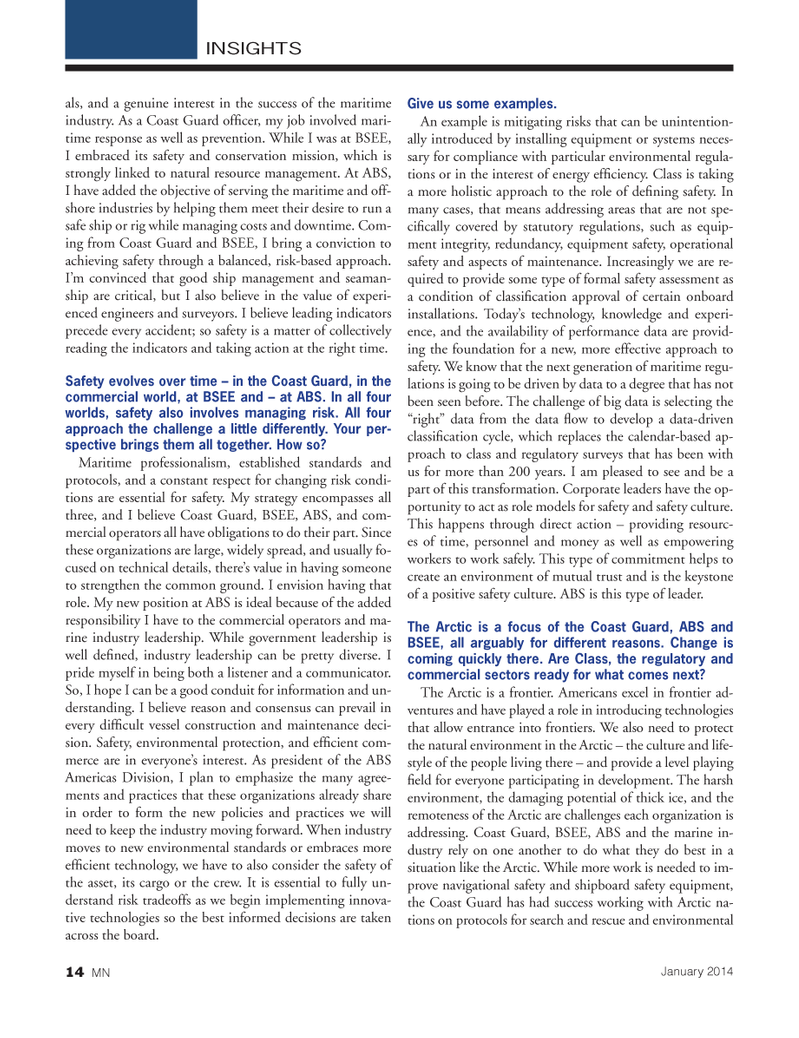
Page 14: of Marine News Magazine (January 2014)
Tug Boat Technology
Read this page in Pdf, Flash or Html5 edition of January 2014 Marine News Magazine
als, and a genuine interest in the success of the maritime industry. As a Coast Guard offi cer, my job involved mari- time response as well as prevention. While I was at BSEE,
I embraced its safety and conservation mission, which is strongly linked to natural resource management. At ABS,
I have added the objective of serving the maritime and off- shore industries by helping them meet their desire to run a safe ship or rig while managing costs and downtime. Com- ing from Coast Guard and BSEE, I bring a conviction to achieving safety through a balanced, risk-based approach.
I’m convinced that good ship management and seaman- ship are critical, but I also believe in the value of experi- enced engineers and surveyors. I believe leading indicators precede every accident; so safety is a matter of collectively reading the indicators and taking action at the right time.
Safety evolves over time – in the Coast Guard, in the commercial world, at BSEE and – at ABS. In all four worlds, safety also involves managing risk. All four approach the challenge a little differently. Your per- spective brings them all together. How so?
Maritime professionalism, established standards and protocols, and a constant respect for changing risk condi- tions are essential for safety. My strategy encompasses all three, and I believe Coast Guard, BSEE, ABS, and com- mercial operators all have obligations to do their part. Since these organizations are large, widely spread, and usually fo- cused on technical details, there’s value in having someone to strengthen the common ground. I envision having that role. My new position at ABS is ideal because of the added responsibility I have to the commercial operators and ma- rine industry leadership. While government leadership is well defi ned, industry leadership can be pretty diverse. I pride myself in being both a listener and a communicator.
So, I hope I can be a good conduit for information and un- derstanding. I believe reason and consensus can prevail in every diffi cult vessel construction and maintenance deci- sion. Safety, environmental protection, and effi cient com- merce are in everyone’s interest. As president of the ABS
Americas Division, I plan to emphasize the many agree- ments and practices that these organizations already share in order to form the new policies and practices we will need to keep the industry moving forward. When industry moves to new environmental standards or embraces more effi cient technology, we have to also consider the safety of the asset, its cargo or the crew. It is essential to fully un- derstand risk tradeoffs as we begin implementing innova- tive technologies so the best informed decisions are taken across the board.
Give us some examples.
An example is mitigating risks that can be unintention- ally introduced by installing equipment or systems neces- sary for compliance with particular environmental regula- tions or in the interest of energy effi ciency. Class is taking a more holistic approach to the role of defi ning safety. In many cases, that means addressing areas that are not spe- cifi cally covered by statutory regulations, such as equip- ment integrity, redundancy, equipment safety, operational safety and aspects of maintenance. Increasingly we are re- quired to provide some type of formal safety assessment as a condition of classifi cation approval of certain onboard installations. Today’s technology, knowledge and experi- ence, and the availability of performance data are provid- ing the foundation for a new, more effective approach to safety. We know that the next generation of maritime regu- lations is going to be driven by data to a degree that has not been seen before. The challenge of big data is selecting the “right” data from the data fl ow to develop a data-driven classifi cation cycle, which replaces the calendar-based ap- proach to class and regulatory surveys that has been with us for more than 200 years. I am pleased to see and be a part of this transformation. Corporate leaders have the op- portunity to act as role models for safety and safety culture.
This happens through direct action – providing resourc- es of time, personnel and money as well as empowering workers to work safely. This type of commitment helps to create an environment of mutual trust and is the keystone of a positive safety culture. ABS is this type of leader.
The Arctic is a focus of the Coast Guard, ABS and
BSEE, all arguably for different reasons. Change is coming quickly there. Are Class, the regulatory and commercial sectors ready for what comes next?
The Arctic is a frontier. Americans excel in frontier ad- ventures and have played a role in introducing technologies that allow entrance into frontiers. We also need to protect the natural environment in the Arctic – the culture and life- style of the people living there – and provide a level playing fi eld for everyone participating in development. The harsh environment, the damaging potential of thick ice, and the remoteness of the Arctic are challenges each organization is addressing. Coast Guard, BSEE, ABS and the marine in- dustry rely on one another to do what they do best in a situation like the Arctic. While more work is needed to im- prove navigational safety and shipboard safety equipment, the Coast Guard has had success working with Arctic na- tions on protocols for search and rescue and environmental
INSIGHTS 14 MN
January 2014
MN JAN14 Layout 1-17.indd 14 12/20/2013 10:03:26 AM

 13
13

 15
15
